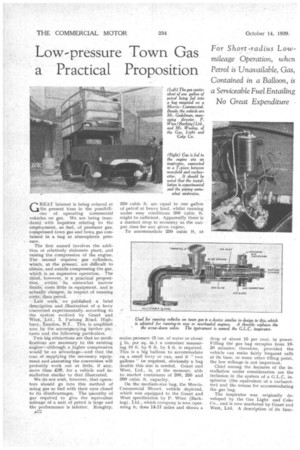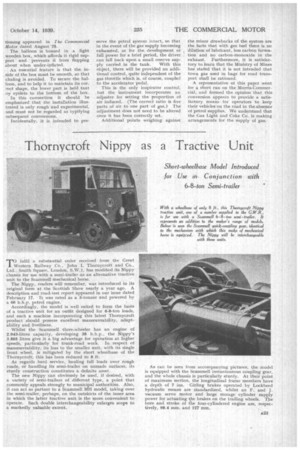Low-pressure Town Gas a Practical Proposition
Page 24

Page 25

If you've noticed an error in this article please click here to report it so we can fix it.
For Short -radius Lowmileage Operation, when Petrol is Unavailable, Gas, Contained in a Balloon, is a Serviceable Fuel Entailing No Great Expenditure
GREAT interest is being evinced at the present time in the possibilities of operating commercial vehicles on gas. We are being inundated•with inquiries relating to the employment, as fuel, of producer gas, compressed town gas and town gas contained in a bag at atmospheric pressure.
The first named involves the addition of relatively elaborate plant, and raising the compression of the engine. The second requires gas cylinders, which, at the present, are difficult to obtain, and entails compressing the gas, which is an expensive operation. The third, however, is a practical proposition, _ within its sornewhat narrow limits, costs little in equipment, and is actually cheaper, in respect.of running cOSts, than petrol.
Last week, we published a brief description and illustration of -a lorry converted experimentallyaccording to the system evolved by Grant and West. Ltd., 3, Furlong Road, Highbury, London, NJ. This is amplified now by the accompanying farther pictures and the following particulars.
Two big attractions are that no modifications are necessary to the existing engine—although a higher compression would be an advantage—and that the . cost of supplying the necessary equipment and executing the conversion will probably work out at little, if any, more than £20, for a vehicle and installation similar to that illustrated.
We do not wish, however, that operators should go into this method of using gas as fuel with their eyes closed to its disadvantages. The quantity of gas required to give the equivalent mileage of a unit of petrol is large and the performance is inferior. Roughly, A22
250 cubic ft. are equal to one gallon of petrolat heavy load, whilst running under easy conditions 200 cubic ft. might be sufficient. Apparently there is a marked drop in economy as the output rises for any given engine.
. To accommodate 250 cubic ft.. at mains pressure (5 ins, of water or about
lb, per sq. in.) a container measuring 10 ft. by 6 ft. by 4 ft. is required. This is a big balloon to accommodate on a small lorry or van, and if "two gallons " be required, obviously a hag double this size is needed. Grant and West, Ltd., is, at the moment, able to market containers of 200, 250 and 300 cubic ft. capacity.
On the medium-size bag, the MorrisCommercial 30-cwt. vehicle depicted, which was equipped to the Grant and West specification by P. Winn (Barking), Ltd., which company, is now operating it, does 14-17 miles and shows a drop of about 15 per cent, in power. Filling the gas bag occupies from 1020 minutes; therefore, provided the vehicle can m'ake fairly frequent calls at its base, or some other filling point. the low mileage is not important.
Chief among the features of the installation under consideration are the inclusion in the system of a G.L.C. inspirator (the equivalent of a carburetter) and the means for accommodating the gas bag.
The inspirator was originally developed by the Gas Light and Coke Co., and is now marketed by Grant and West, Ltd. A description of its func
boning appeared in The Commercial Motor dated August 25.
The balloon is housed in a light wooden box, which affords it rigid support and prevents it from flopping about when under-inflated.
• An essential feature is that the inside of the box must be smooth, so that chafing is avoided. To secure the balloon, and to help it to maintain its correct shape, the lower part is held taut oy eyelets to the bottom of the box. In this connection it should be emphasized that the installation illustrated is only rough and experimental, and must not be regarded as typifying subsequent conversions.
Incidentally, it is intended to pre serve the petrol system. intact, so that in the event of the gas supplybecoming exhausted, or for the. development of full power for a brief period, the driver can fall back upon a small reserve sup
ply carried in the tank. With this object, there will be provided an additional control, quite independent of the gas throttle which is, of course, coupled to the accelerator pedal.
This is the only inSpirator control, but the instrument incorporates an adjuster for setting the proportion of air induced. (The correct ratio is five parts of air to one part of gas.) The adjustment does not need to be altered once it has been correctly set.
Additional points weighing against the minor drawbacks of the system are the facts that with gas fuel there is no dilution of lubricant, less carbon formation and no carbon-monoxide in the exhaust. Furthermore, it is satisfactory to learn that the Ministry of Mines has stated that it is not intended that town gas used in bags for road transport shall be rationed.
A representative of this paper went for a short run OD the Morris-Commercial, and formed the opinion that this conversion appears to provide a satisfactory means for operators to keep their vehicles on the road in the absence of petrol supplies. We understand that the Gas Light and Coke Co. is making arrangements for the gupply of gas.




















































